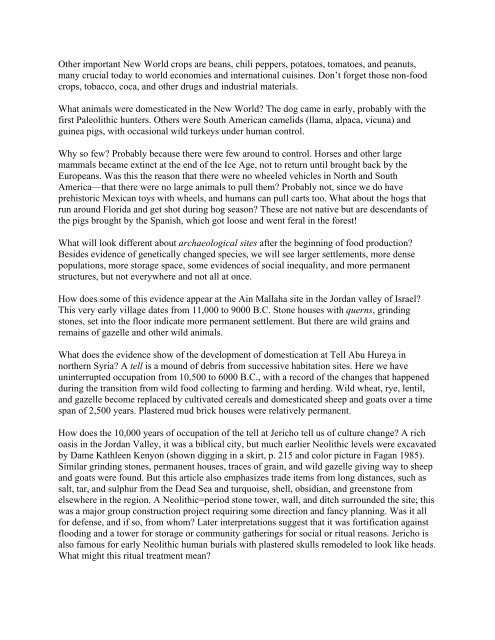INTRODUCTION TO ARCHAEOLOGY Nancy White - Touro Institute
INTRODUCTION TO ARCHAEOLOGY Nancy White - Touro Institute
INTRODUCTION TO ARCHAEOLOGY Nancy White - Touro Institute
Create successful ePaper yourself
Turn your PDF publications into a flip-book with our unique Google optimized e-Paper software.
Other important New World crops are beans, chili peppers, potatoes, tomatoes, and peanuts,<br />
many crucial today to world economies and international cuisines. Don’t forget those non-food<br />
crops, tobacco, coca, and other drugs and industrial materials.<br />
What animals were domesticated in the New World? The dog came in early, probably with the<br />
first Paleolithic hunters. Others were South American camelids (llama, alpaca, vicuna) and<br />
guinea pigs, with occasional wild turkeys under human control.<br />
Why so few? Probably because there were few around to control. Horses and other large<br />
mammals became extinct at the end of the Ice Age, not to return until brought back by the<br />
Europeans. Was this the reason that there were no wheeled vehicles in North and South<br />
America—that there were no large animals to pull them? Probably not, since we do have<br />
prehistoric Mexican toys with wheels, and humans can pull carts too. What about the hogs that<br />
run around Florida and get shot during hog season? These are not native but are descendants of<br />
the pigs brought by the Spanish, which got loose and went feral in the forest!<br />
What will look different about archaeological sites after the beginning of food production?<br />
Besides evidence of genetically changed species, we will see larger settlements, more dense<br />
populations, more storage space, some evidences of social inequality, and more permanent<br />
structures, but not everywhere and not all at once.<br />
How does some of this evidence appear at the Ain Mallaha site in the Jordan valley of Israel?<br />
This very early village dates from 11,000 to 9000 B.C. Stone houses with querns, grinding<br />
stones, set into the floor indicate more permanent settlement. But there are wild grains and<br />
remains of gazelle and other wild animals.<br />
What does the evidence show of the development of domestication at Tell Abu Hureya in<br />
northern Syria? A tell is a mound of debris from successive habitation sites. Here we have<br />
uninterrupted occupation from 10,500 to 6000 B.C., with a record of the changes that happened<br />
during the transition from wild food collecting to farming and herding. Wild wheat, rye, lentil,<br />
and gazelle become replaced by cultivated cereals and domesticated sheep and goats over a time<br />
span of 2,500 years. Plastered mud brick houses were relatively permanent.<br />
How does the 10,000 years of occupation of the tell at Jericho tell us of culture change? A rich<br />
oasis in the Jordan Valley, it was a biblical city, but much earlier Neolithic levels were excavated<br />
by Dame Kathleen Kenyon (shown digging in a skirt, p. 215 and color picture in Fagan 1985).<br />
Similar grinding stones, permanent houses, traces of grain, and wild gazelle giving way to sheep<br />
and goats were found. But this article also emphasizes trade items from long distances, such as<br />
salt, tar, and sulphur from the Dead Sea and turquoise, shell, obsidian, and greenstone from<br />
elsewhere in the region. A Neolithic=period stone tower, wall, and ditch surrounded the site; this<br />
was a major group construction project requiring some direction and fancy planning. Was it all<br />
for defense, and if so, from whom? Later interpretations suggest that it was fortification against<br />
flooding and a tower for storage or community gatherings for social or ritual reasons. Jericho is<br />
also famous for early Neolithic human burials with plastered skulls remodeled to look like heads.<br />
What might this ritual treatment mean?
















